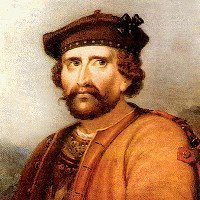Rob Roy MacGregor 1671 – 1734 was known as a thief and extortionist but also a daring hero, few men have been as celebrated in folk legend or literature as Robert Roy MacGregor.
 He was born in March 1671 in Glen Goyle in the southern Highlands, the third son of Donald Glas, a MacGregor chieftain, and Mary Campbell. From an early age he was given the nickname Ruadh, Gaelic for red because of the colour of his hair, later anglicised to Roy.
He was born in March 1671 in Glen Goyle in the southern Highlands, the third son of Donald Glas, a MacGregor chieftain, and Mary Campbell. From an early age he was given the nickname Ruadh, Gaelic for red because of the colour of his hair, later anglicised to Roy.
He started his own business dealing cattle under the patronage of the Duke of Montrose. He became very successful and earned the lands and title of Laird of Inversnaid in the process.
However, Rob Roy’s success was undone in 1711 when, having borrowed the huge sum of £1000 from Montrose, his chief drover stole the money. Although Rob Roy tried to catch the culprit and promised to repay the loan, Montrose declared him to be a thief. He was made bankrupt, his lands were repossessed and he was forced to go on the run.
Legend has it that when the soldiers came to evict the MacGregors his wife was branded and raped by the government men.
Rob Roy became an outlaw and pursued a vendetta against the Duke of Montrose. He rustled cattle, stealing the animals and extorting money from farmers to ‘protect’ them from other rustlers. The feud returned Rob Roy to the political stage by making him a friend of the Duke’s enemies, who sheltered him from pursuit.
At this time his generosity to the poor, especially those ill-used by the Duke of Montrose, earned him a reputation as a friend of the common man.
When Daniel Defoe wrote a fictionalized account of his life in 1723 called Highland Rogue , Rob Roy became a legend in his own lifetime. His popularity with the public led to a pardon for his crimes from George I just as he was about to be transported to the colonies.
His life continued to fascinate artists after his death. The publication of “Rob Roy” by Sir Walter Scott in 1818 further added to his fame. William Wordsworth wrote a poem called Rob Roy’s Grave during a visit to Scotland and he has been the hero of many films.
Rob Roy spent the last years of his life in peace at Balquhidder. He died on 28 December 1734 at his home at the age of 63 as a piper played I Shall Return No More . He was buried on New Year’s Day at the Old Kirk Yard in Balquhidder 1735 and was survived by four sons.
The inscription on his grave, added in the twentieth century, reads ‘MacGregor Despite Them‘.
